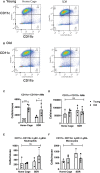Psychological stress creates an immune suppressive environment in the lung that increases susceptibility of aged mice to Mycobacterium tuberculosis infection
- PMID: 36189368
- PMCID: PMC9523253
- DOI: 10.3389/fcimb.2022.990402
Psychological stress creates an immune suppressive environment in the lung that increases susceptibility of aged mice to Mycobacterium tuberculosis infection
Abstract
Age is a major risk factor for chronic infections, including tuberculosis (TB). Elderly TB patients also suffer from elevated levels of psychological stress. It is not clear how psychological stress impacts immune response to Mycobacterium tuberculosis (M.tb). In this study, we used social disruption stress (SDR) to investigate effects of psychological stress in young and old mice. Unexpectedly, we found that SDR suppresses lung inflammation in old mice as evidenced by lower pro-inflammatory cytokine levels in bronchial lavage fluid and decreased cytokine mRNA expression by alveolar macrophages. To investigate effects of stress on M.tb infection, mice were subjected to SDR and then infected with M.tb. As previously reported, old mice were better at controlling infection at 30 days than young mice. This control was transient as CFUs at 60 days were higher in old control mice compared to young mice. Consistently, SDR significantly increased M.tb growth at 60 days in old mice compared to young mice. In addition, SDR in old mice resulted in accumulation of IL-10 mRNA and decreased IFN-γ mRNA at 60 days. Also, confocal microscopy of lung sections from old SDR mice showed increased number of CD4 T cells which express LAG3 and CD49b, markers of IL-10 secreting regulatory T cells. Further, we also demonstrated that CD4 T cells from old SDR mice express IL-10. Thus, we conclude that psychological stress in old mice prior to infection, increases differentiation of IL-10 secreting T cells, which over time results in loss of control of the infection.
Keywords: IL10; Mycobacterium tuberculosis; aging; granuloma; inflammaging; social stress.
Copyright © 2022 Lafuse, Wu, Kumar, Saljoughian, Sunkum, Ahumada, Turner and Rajaram.
Conflict of interest statement
The authors declare that the research was conducted in the absence of any commercial or financial relationships that could be construed as a potential conflict of interest.
Figures








Similar articles
-
Protection against Mycobacterium tuberculosis infection offered by a new multistage subunit vaccine correlates with increased number of IFN-γ+ IL-2+ CD4+ and IFN-γ+ CD8+ T cells.PLoS One. 2015 Mar 30;10(3):e0122560. doi: 10.1371/journal.pone.0122560. eCollection 2015. PLoS One. 2015. PMID: 25822536 Free PMC article.
-
Mycobacterium tuberculosis multi-drug-resistant strain M induces IL-17+ IFNγ- CD4+ T cell expansion through an IL-23 and TGF-β-dependent mechanism in patients with MDR-TB tuberculosis.Clin Exp Immunol. 2017 Jan;187(1):160-173. doi: 10.1111/cei.12873. Epub 2016 Nov 2. Clin Exp Immunol. 2017. PMID: 27681197 Free PMC article.
-
IL-4 subverts mycobacterial containment in Mycobacterium tuberculosis-infected human macrophages.Eur Respir J. 2019 Aug 8;54(2):1802242. doi: 10.1183/13993003.02242-2018. Print 2019 Aug. Eur Respir J. 2019. PMID: 31097521
-
Functional Signatures of Human CD4 and CD8 T Cell Responses to Mycobacterium tuberculosis.Front Immunol. 2014 Apr 22;5:180. doi: 10.3389/fimmu.2014.00180. eCollection 2014. Front Immunol. 2014. PMID: 24795723 Free PMC article. Review.
-
Tuberculosis in the elderly: Why inflammation matters.Exp Gerontol. 2018 May;105:32-39. doi: 10.1016/j.exger.2017.12.021. Epub 2017 Dec 26. Exp Gerontol. 2018. PMID: 29287772 Free PMC article. Review.
Cited by
-
CD4+ Effective Memory T Cell Markers GBP2 and LAG3 Are Risk Factors for PTB and COVID-19 Infection: A Study Integrating Single-Cell Expression Quantitative Trait Locus and Mendelian Randomization Analyses.Int J Mol Sci. 2024 Sep 16;25(18):9971. doi: 10.3390/ijms25189971. Int J Mol Sci. 2024. PMID: 39337460 Free PMC article.
References
-
- Allen R. G., Lafuse W. P., Powell N. D., Webster Marketon J. I., Stiner-Jones L. M., Sheridan J. F., et al. . (2012). Stressor-induced increase in microbicidal activity of splenic macrophages is dependent upon peroxynitrite production. Infection Immun. 80, 3429–3437. doi: 10.1128/IAI.00714-12 - DOI - PMC - PubMed
Publication types
MeSH terms
Substances
Grants and funding
LinkOut - more resources
Full Text Sources
Medical
Research Materials
Miscellaneous

